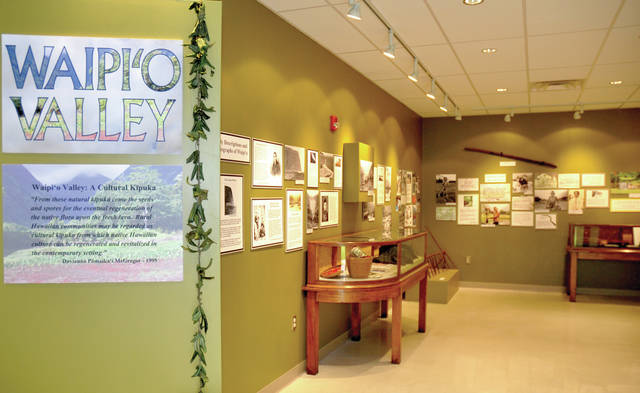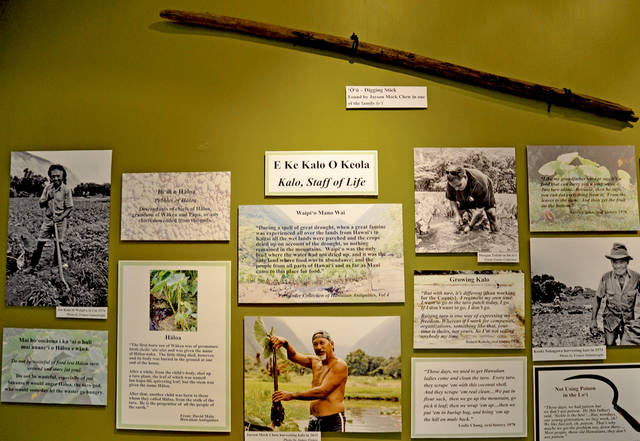HONOKAA — An exhibit on Waipio Valley opened in late September at North Hawaii Education and Research Center’s (NHERC) Heritage Center, curated by Dr. Momi Naughton, the center’s director.
Community members gathered and were treated to the music of Darlene Ahuna and the chicken-skin chanting of Lanakila Mangauil, along with an array of photos, stories and myths depicting all aspects of life in the valley.
The idea for the exhibit came from the community.
“It was Valerie Poindexter that wanted me to do it, but what a huge responsibility to try to interpret it,” Naughton said. “I started with reading three different oral histories and just let them guide me.”
The exhibit, which remains open to the public weekdays and Saturdays, is infused with the spirit of community and cultural kipuka, beginning with a quote by Davianna Pomaikai McGregor.
“From these natural kipuka come the seeds and spores for the eventual regeneration of the native flora upon the fresh lava. Rural Hawaiian communities may be regarded as cultural kipuka from which native Hawaiian culture can be regenerated and revitalized in the contemporary setting,” he said.
The valley itself, once the seat of government of High Chief Umi, is a many-storied metaphor for a long legacy of life-sustaining practices that have emerged from a spiritual connection to the natural world. This can be seen in the first section of the exhibit, which has early descriptions and photos of Waipio.
“What’s really striking is the valley is only a mile wide and 6 miles long and yet there were seven heiau. It just gives you an idea of what a deeply spiritual place it is,” Naughton said.
Through oral histories and other sources, she looked at every aspect of life in the valley.
“They walked up and down the valley to go to school. There was a store and they had a school down there and all sorts of gathering places where people got together,” she said.
The black and white photography of Franco Solmoiraghi is a stunning addition to the exhibit, capturing the people and lifestyle of Waipio.
Historically, with an estimated peak population around 4,000, the cultivation of kalo and other foods has always been central to life in Waipio Valley and at times crucial to those who lived beyond the valley.
“There’s records of drought when everywhere else was dry and Waipio still had water. Waipio was the breadbasket,” Naughton said.
Arriving sometime in the 1800s, Chinese grew rice in the valley until California rice took over the market in the 1920s, then they began growing kalo.
“A lot of people have memories of the Chinese doing rice farming. After work the Chinese would come home, smoke opium, go to sleep and be wide awake and ready to go the next day,” she said.
Later, the Japanese arrived.
“Tokojiro Sato was in the first group of Japanese that came to Hawaii in the 1860s. They’re doing a documentary on him and the Japanese consulate is getting involved. The family lore was always that he worked for Parker Ranch and I just found some documentation for that. He was a steward for Samuel Parker,” Naughton said.
There is also a contribution from the Tokojiro (now Toko) family in the exhibit.
“I wanted to feature something about crafts and lauhala weaving and Debbie Toko happened to come in carrying this gorgeous purse she had made. She wanted to make sure that we included her kumu and how they were teaching the future generations,” Naughton said.
The lore of Waipio is an enticement for students through which they can connect to the rich history and wisdom of Waipio.
“What draws the kids the most is the moolelo (story). As you go down into Waipio there’s the pohaku of Puapualenalena. The kids knew the story, how they pushed the rock over one day to widen the road and the next day it was right back where it was. And of course they all knew about night marchers,” Naughton said.
The oral histories also led her to explore various aspects of Waipio’s natural world.
“I looked at what was important to them. That’s where I came up with the idea of covering the fragile ecosystem,” Naughton said.
An entire wall is dedicated to how different plants and animals got to the valley.
“Everything here is either a canoe plant or endemic,” she said. “These plants were used as medicine.”
A section of the display shows the fascinating endemic life of forest and stream.
“The hiiwai snail is endemic and very endangered. They have a suction cup and are like an opihi,” Naughton remarked.
The oopu nopili (endemic freshwater stream fish), which are getting pushed out by the tilapia fish, are well adapted to stream life in Waipio.
“They can scale up 400-foot waterfalls. They have suction cups and when they reach adulthood their upper lip can be used to hook on crevices to help pull themselves up,” Naughton said.
Another section is devoted to invasive species and crazy schemes over the years.
“At one point they were going to do a gourmet frog leg farm. Also a steam plant and then commercial hiking tours. People also wanted to do things at the mouth of the valley where there are Hawaiian burials,” she said.
A monument to one of the slightly less crazy schemes is a metal and glass “teahouse” built without permits. Now derelict, it sits on a rise with Hiilawe Falls as a backdrop.
The exhibit offers a glimpse into Waipio with its history of Hawaiian cultural practices and provides a foundation for looking at the future of the valley.
“The future of Waipio has been so fraught with controversy and so that’s something I wanted to touch on from the perspective of the farmers,” Naughton concluded.
For info or exhibit hours: Call NHERC at 775-8890 or go to https://hilo.hawaii.edu/nherc/HeritageCenter.php


